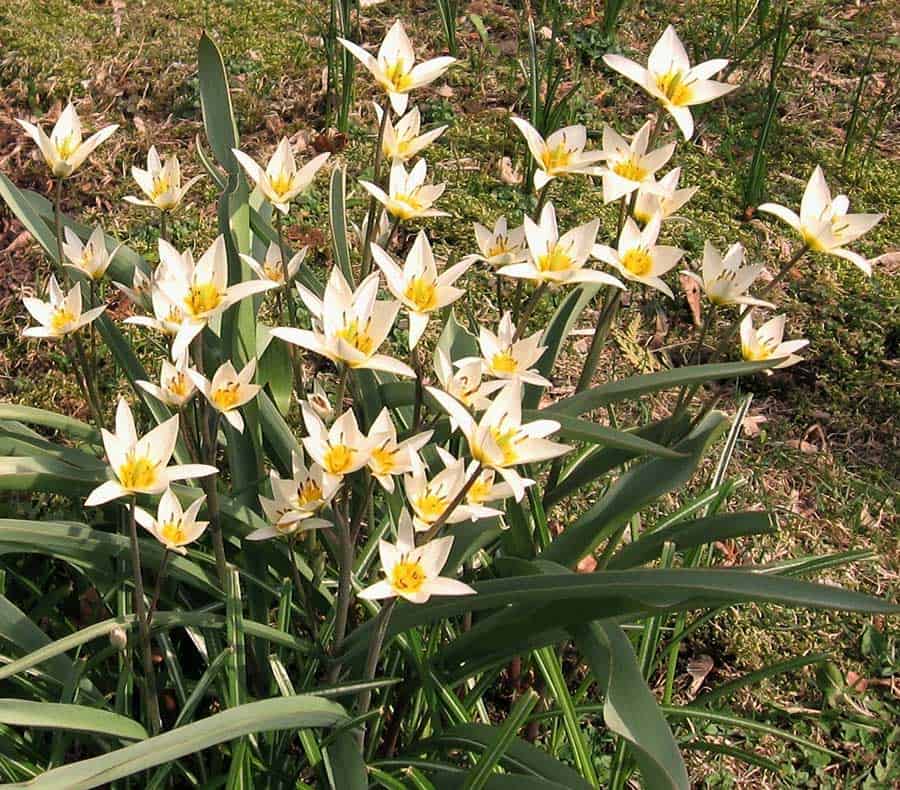
These days, you’re likely to find more than just grass growing in many Canadian lawns. This is especially true for those of us who live in provinces where cosmetic herbicides have been banned for almost a decade, and where completely weed-free lawns are rare. But attitudes have shifted, and a few dandelions here and there no longer illicit the horrified gasps they might have done in the past.
But in addition to weedy, uninvited invasives, there are a host of beautiful bulbous flowers that embellish lawns in early spring and then politely retreat underground by the time the grass needs mowing. My own lawn is studded with clumps of early daffodils, Spanish bluebells (Hyacinthoides hispanica cvs.), white hyacinths (pink- and blue-flowered types look better in borders and pots) and species tulips.
Many of these early bulbs are ideal for challenging areas where turfgrass growth is already sparse due to deciduous shade, competitive tree roots or moist, mossy areas that are slow to dry out in spring. The southeast corner of my garden boasts all three of these limiting factors, and that is where I grow several thriving patches of the Turkestan species tulip (Tulipa turkestanica, Zone 3) which are blooming their heads off right now.

The Turkestan tulip is always the first tulip to break bud in my Zone 5a garden. It has grey-green foliage and branching flowering stems that bear up to 12 star-shaped ivory-white flowers with yellow-orange centres, although three or four blooms per stem is the norm. The flower buds all open simultaneously — which makes for an exuberant show, although they remain closed on cold, wet, overcast days when sensible insect pollinators stay at home.
As with all tulips, the opening and closing of flowerheads is achieved by adding cells to the base of the flower (to close) or to the tips (to open) in reaction to heat and light levels. The end result is that mature tulip flowers are always larger than newly opened ones, and the one-inch (2.5-cm)-wide flowers of my Turkestan tulips will have doubled in size before they drop their tepals (i.e., petals) in a couple of weeks.
Almost half of the 120 or so species (or “botanical”) tulips — including Tulipa turkestanica — call the Tian Shan in central Asia home, and this is where German plant hunter extraordinaire Eduard von Regel (1815-92) discovered it growing in 1873. Von Regel had moved to St. Petersburg in 1855 and eventually became director of the Russian Imperial Botanical Garden, a position that enabled him to participate in far-flung plant-collecting expeditions; by the end of his career he had described and named an astonishing 3,000 new species.
I often think of Herr von Regel when I bend down to admire my 10-inch (25-cm)-tall Turkestan tulips, and speculate what insects pollinate them in their homeland as I catch a whiff of their rather putrid-smelling flowers. Unlike modern cultivars, their three inner tepals are almost twice as wide as their three outer ones, and despite the efforts of plant hybridizers to use the Turkestan tulip in the breeding of new multi-stemmed varieties, T. turkestanica refuses to cross-breed with large-flowered modern cultivars — or as tulip expert Anna Pavord puts it, “Once more, the tulip spurns the pimp.”
I grow several other species tulips in my turfgrass, and another favourite is the lady tulip (T. clusiana) with its deep pink-striped white flowers — not unlike the “Canada 150” tulip. Lady tulips have been in cultivation since the early 1600s, and worthy cultivars such as ‘Lady Jane’ and ‘Peppermintstick’ are often easier to obtain than the species form.
In another challenging spot — beneath a malevolent, shallow-rooted Norway maple — I’ve been experimenting with grape hyacinths (Muscari cvs.). This is only their second spring, but already they seem to be spreading contentedly in the dry, exhausted soil where even turfgrass fears to tread. Two years from now, I hope that the view from my front window will be a solid sea of blue.
What’s blooming in your lawn this spring?
Do you grow spring-flowering bulbs in your Canada 150 lawn?


I am intrigued. We lived without a lawn in a mountainous area for some time, are now in Calgary with clay soil, west sun and (hopefully) a zone 4a climate. We just had this 25 year old lawn aerated. If I plant some lawn bulbs, does that mean no aeration in future?
I look forward to the intense blue of scilla or squill in a difficult area below trees. It is gradually spreading into the turf grass and that is fine by me. I wish more people planted it -I might have to put some into the grassy boulevards on my street !
Hello Jessica,
Yes, it’s fantastic that so many early spring bulbs can cope so well with otherwise inhospitable conditions. I’ve been truly impressed by the tenacity of Scilla, Chionodoxa and Muscari spp. and cvs. in areas where it’s difficult to even get turfgrass established. (For me, this means underneath two mature [inherited!] red-leaved Norway maples).
And I expect that your nearby “grassy boulevards” would welcome a spot of benign guerilla gardening 😉
Scilla are definitely beautiful but the also spread readily. Because of this they often end up in natural areas like woodlots where they out compete natives like trilliums Pleas think carefully before adding them to your landscape. I love scilla but wonder if we should be encouraging their use.
Hi Stephen,
I grow crocus and chionodoxia in my lawn in Montréal.
Beautiful!
Hi Sylvain,
The two early-flowering spring bulbs you mention are *perfect* candidates for naturalizing in turfgrass! Incidentally, crocuses open and close their flowers the same way that tulips do–by adding cells to the bottom of the blooms (to close) and to the tips (to open).
Keeping blooms tightly shut during cold, wet weather ensures that the flower’s precious pollen is only available when insect pollinators are active, and more importantly, it keeps “the ammo” dry on rainy days.
While probably technically not bulbs, I have anemones (Grecian Windflower) blooming in my lawn as well as Glory of the Snow. White and purple Dog-tooth Violets also appear. I am in Stratford, ON
Hello Gail,
I couldn’t agree with you more about the many virtues of Grecian windflowers (Anemone blanda cvs.). They sprout from knobby little tubers (or modified stems) but are generally grouped together with corms (also a sort of modified storage stem) and true bulbs. I have a patch of A. b. ‘White Splendour’ which has been in bloom for over a month now. The cool, moist spring that Ontario is experiencing this year is keeping many spring-flowering bulbs in bloom for much longer than usual (notably daffodils and hyacinths, in addition to the minor bulbs).
And dog’s-tooth violets (Erythronium dens-canis and cvs.) are a huge sentimental favourite for me. Where I live on the eastern shore of Lake Simcoe, native stands of the closely-related yellow trout lily (E. americanum) are fairly common, but are often reticent to flower. Incidentally, Erythronium species and cultivars are usually called “bulbous perennials.”